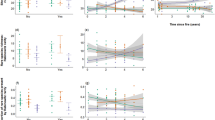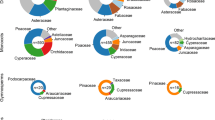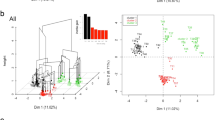Abstract
To effectively manage plant populations for conservation, there is a need to provide reliable information on the conditions required for maintaining viable populations. This is particularly true for the management of populations of rare plant taxa. Western Australia contains over 45% of Australia’s gazetted rare or threatened flora, 80% of which are found within the highly fragmented southwest region. Resources do not exist to undertake comprehensive studies on the population dynamics and demographics for every rare plant of this diverse region. Here, we describe a method of classifying rare plant taxa into functional groups as a basis for guiding rare flora conservation and management. Data on four floral and two life-history traits were collected for each of the 351 declared rare flora taxa of Western Australia. A hierarchical, agglomerative clustering method was applied to the resulting taxa by traits matrix to extract emergent groupings of plant taxa. The resulting polythetic groups were analysed to determine the variation in traits, including response to disturbance and recorded flower visitors, and how these may affect population persistence in a fragmented landscape. Multivariate methods were used to define emergent groups based on a combination of floral structure and life-history traits of the declared rare flora of Western Australia. Seven emergent functional groups were identified and were largely differentiated by flower shape and life form. These seven functional groupings varied significantly in their response to disturbance. By deriving these functional groups, we plan to develop models for each group on how rates of pollination, seed production and seed fitness are affected by population size and landscape context. The rationale would be to use these profiles to determine whether there are thresholds in population size or position in the landscape at which reproductive rates severely decline. General management guidelines could then be developed for each functional group.



Similar content being viewed by others
Abbreviations
- DRF:
-
Declared rare flora
- SWAFR:
-
Southwest Australian Floristic Region
References
Aizen MA, Feinsinger P (1994) Forest fragmentation, pollination, and plant reproduction in a Chaco dry forest, Argentina. Ecology 75:330–351. doi:10.2307/1939538
Blondel J (2003) Guilds or functional groups: does it matter? Oikos 100:223–231. doi:10.1034/j.1600-0706.2003.12152.x
Bond WJ (1994) Do mutualisms matter? Assessing the impact of pollinator and disperser disruption on plant extinction. Philos Trans R Soc Lond Ser B 344:83–90. doi:10.1098/rstb.1994.0055
Bradstock RA, Kenny BJ (2003) An application of plant functional types to fire management in a conservation reserve in southeastern Australia. J Veg Sci 14:345–354. doi:10.1658/1100-9233(2003)014[0345:AAOPFT]2.0.CO;2
Brown A, Thomson-Dans C, Marchant N (eds) (1998) Western Australia’s threatened flora. Department of Conservation and Land Management, Perth
Clarke KR, Gorley RN (2001) PRIMER v5: user manual/tutorial. PRIMER-E, Plymouth
Coates DJ, Atkins KA (2001) Priority setting and the conservation of Western Australia’s diverse and highly endemic flora. Biol Conserv 97:251–263. doi:10.1016/S0006-3207(00)00123-3
Dafni A (1992) Pollination ecology. A practical approach. Oxford University Press, Oxford
Díaz S, Cabido M (2001) Vive la différence: plant functional diversity matters to ecosystem processes. Trends Ecol Evol 16:646–655. doi:10.1016/S0169-5347(01)02283-2
Endress PK (1994) Diversity and evolutionary biology of tropical flowers. Cambridge University Press, Cambridge
Faegri K, van der Pijl L (1979) The principles of pollination ecology. Pergamon Press, Oxford
Gitay H, Noble IR (1997) What are functional types and how should we seek them? In: Smith TM, Shugart HH, Woodward FI (eds) Plant functional types. Cambridge University Press, Cambridge, pp 3–19
Glanznig A (1995) Native vegetation clearance, habitat loss and biodiversity decline. An overview of recent native vegetation clearance in Australia and its implications for biodiversity. Biodiversity Unit, Department of the Environment, Sport and Territories, Canberra
Gower JC (1971) A general co-efficient of similarity and some of its properties. Biometrics 27:857–871. doi:10.2307/2528823
Hobbs RJ (1993) Effects of landscape fragmentation on ecosystem processes in the Western Australian wheatbelt. Biol Conserv 64:193–201. doi:10.1016/0006-3207(93)90321-Q
Hopper SD, Gioia P (2004) The Southwest Australian Floristic Region: evolution and conservation of a global hot spot of diversity. Annu Rev Ecol Evol Syst 35:623–650. doi:10.1146/annurev.ecolsys.35.112202.130201
Jennersten O (1988) Pollination in Dianthus deltoides (Caryophyllaceae): effects of habitat fragmentation on visitation and seed set. Conserv Biol 2:359–366. doi:10.1111/j.1523-1739.1988.tb00200.x
Johnson SD, Steiner KE (2000) Generalization versus specialization in plant pollination systems. Trends Ecol Evol 15:140–143. doi:10.1016/S0169-5347(99)01811-X
Kearns CA, Inouye DW, Waser NM (1998) Endangered mutualisms: the conservation of plant–pollinator interactions. Annu Rev Ecol Syst 29:83–112. doi:10.1146/annurev.ecolsys.29.1.83
Kolb A, Diekmann M (2005) Effects of life-history traits on responses of plant species to forest fragmentation. Conserv Biol 19:929–938. doi:10.1111/j.1523-1739.2005.00065.x
Lambeck RJ (1997) Focal species: a multi-species umbrella for nature conservation. Conserv Biol 11:849–856. doi:10.1046/j.1523-1739.1997.96319.x
Lavorel S, Garnier E (2002) Predicting changes in community composition and ecosystem functioning from plant traits: revisiting the Holy Grail. Funct Ecol 16:545–556. doi:10.1046/j.1365-2435.2002.00664.x
Lavorel S, McIntyre S, Landsberg J, Forbes TDA (1997) Plant functional classifications: from general groups to specific groups based on response to disturbance. Trends Ecol Evol 12:474–478. doi:10.1016/S0169-5347(97)01219-6
Ludwig JA, Reynolds JF (1988) Statistical ecology: a primer on methods and computing. Wiley, New York
McIntyre S, Díaz S, Lavorel S, Cramer W (1999) Plant functional types and disturbance dynamics—introduction. J Veg Sci 10:604–608. doi:10.2307/3237077
Noble IR, Gitay H (1996) A functional classification for predicting the dynamics of landscapes. J Veg Sci 7:329–336. doi:10.2307/3236276
Noble IR, Slatyer RO (1980) The use of vital attributes to predict successional changes in plant communities subject to recurrent disturbances. Vegetatio 43:5–21. doi:10.1007/BF00121013
Paczkowska G, Chapman AR (2000) The Western Australian Flora. Wildflower Society of Western Australia, Western Australian Herbarium, Department of Conservation and Land Management, Botanic Gardens and Parks Authority, Perth
Saunders DA, Hobbs RJ, Margules CR (1991) Biological consequences of ecosystem fragmentation: a review. Conserv Biol 5:18–32. doi:10.1111/j.1523-1739.1991.tb00384.x
Smith TM, Shugart HH, Woodward FI, Burton PJ (1993) Plant functional types. In: Solomon SM, Shugart HH (eds) Vegetation dynamics and global change. Chapman & Hall, New York, pp 272–292
Spira TP (2001) Plant pollinator interactions; a threatened mutualism with implications for the ecology and management of rare plants. Nat Areas J 21:78–88
Thompson JD (2001) How do visitation patterns vary among pollinators in relation to floral display and floral design in a generalist pollination system? Oecologia 126:386–394. doi:10.1007/s004420000531
Walker J, Hopkins MS (1990) Vegetation. In: McDonald RC, Isbell RF, Speight JG, Walker J, Hopkins MS (eds) Australian soil and land survey handbook. Inkata Press, Melbourne, pp 58–86
Waser NM, Chittka L, Price MV, Williams NM, Ollerton J (1996) Generalization in pollination systems, and why it matters. Ecology 77:1043–1060. doi:10.2307/2265575
Western Australian Herbarium (1998) FloraBase—information on the Western Australian Flora. Department of Conservation and Land Management, Perth. http://florabase.calm.wa.gov.au
Woodward FI, Cramer W (1996) Plant functional types and climatic changes. Introduction. J Veg Sci 7:306–308
Yates CJ, Ladd PG (2004) Breeding system, pollination and demography in the rare granite shrub Verticordia staminosa ssp. staminosa in south-west Western Australia. Austral Ecol 29:189–200. doi:10.1111/j.1442-9993.2004.01336.x
Acknowledgements
Australian Research Council (ARC Linkage) provided financial support for this project (AJF). The Western Australian Herbarium (PERTH) is thanked for granting access to plant specimens of the DRF. Ms. Sarah Xu prepared Fig. 1. Don Butler (BRI) provided comments on an early version of the manuscript and assisted in the PRIMER analyses.
Author information
Authors and Affiliations
Corresponding author
Additional information
Nomenclature Paczkowska and Chapman (2000).
Electronic supplementary material
Below is the link to the electronic supplementary material.
Rights and permissions
About this article
Cite this article
Franks, A.J., Yates, C.J. & Hobbs, R.J. Defining plant functional groups to guide rare plant management. Plant Ecol 204, 207–216 (2009). https://doi.org/10.1007/s11258-009-9585-4
Received:
Accepted:
Published:
Issue Date:
DOI: https://doi.org/10.1007/s11258-009-9585-4




